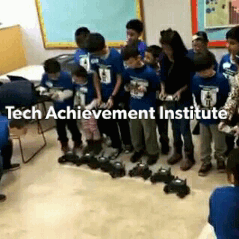#learningrobot
Explore tagged Tumblr posts
Text
The Importance of Robotics & STEM Labs in Education

Education today is evolving beyond traditional methods. With rapid advancements in technology, students need more than just textbook knowledge to succeed in the future. Robotics and STEM (Science, Technology, Engineering, and Mathematics) labs have become essential in schools to prepare children for the challenges of tomorrow. These labs make learning fun, practical, and engaging while teaching critical skills like problem-solving, creativity, and teamwork.
What Are Robotics and STEM Labs?
Robotics and STEM labs are spaces where students can explore science and technology through hands-on activities. They encourage children to design, build, and experiment with tools and concepts they learn in class. Instead of just reading about theories, students get to apply them in real-life projects.
For example, a STEM lab for school allows kids to explore various subjects like math, engineering, and coding in an integrated way. Activities like building circuits, coding robots, or conducting experiments make learning exciting and relatable.
Why Are Robotics and STEM Labs Essential?
1. Preparing Students for the FutureAs technology advances, careers in robotics, AI, and engineering are becoming more important. Introducing these concepts early helps students develop the skills they need to excel in such fields. A Robotics Lab for Kids in School in India gives children an opportunity to learn coding and programming, which are critical skills for the future job market.
2. Encouraging Hands-On LearningRobotics and STEM labs emphasize learning by doing. This method helps students understand complex topics more easily than traditional teaching methods. For instance, building a robot involves using math for calculations and science to understand mechanics, making these subjects more engaging.
3. Fostering Creativity and InnovationThese labs encourage kids to think creatively. Whether it’s designing a robot or solving a technical challenge, students learn to innovate and come up with unique ideas. This boosts their confidence and helps them tackle problems in creative ways.
4. Developing Problem-Solving SkillsIn a robotics or STEM lab, students face real-world challenges that require critical thinking and problem-solving. For example, if a robot doesn’t work as intended, kids analyze the problem, test solutions, and make improvements. This process teaches them resilience and logical thinking.
5. Building Teamwork and CollaborationMany projects in these labs are done in groups, which helps students learn how to work together. They share ideas, communicate effectively, and respect each other’s contributions. These teamwork skills are essential for both school and future careers.
The Role of STEM Labs in Schools
Introducing a STEM lab for school can transform the way students learn. These labs bridge the gap between theoretical lessons and real-life applications, making education more practical and enjoyable.
STEM labs also encourage curiosity and experimentation. Students can explore new topics, try out ideas, and see the results of their efforts firsthand. This not only makes learning enjoyable but also inspires them to explore careers in science and technology.
Robotics Labs: Shaping the Future
Robotics labs take STEM education to the next level by introducing students to advanced technologies. A well-equipped Robotic Lab for School teaches kids how to design, program, and control robots. This hands-on experience builds their technical knowledge and prepares them for careers in robotics, AI, and automation.
In India, schools are increasingly adopting robotics labs to keep up with global educational trends. These labs provide students with early exposure to advanced technologies, ensuring they are future-ready.
For example, a project where students build a robot to clean waste not only teaches technical skills but also instills social responsibility. Such activities make learning purposeful and impactful.
Why Schools Should Invest in Robotics and STEM Labs
1. Makes Learning Fun and EngagingRobotics and STEM labs turn learning into an adventure. Students look forward to exploring, experimenting, and creating, which makes education enjoyable.
2. Builds Practical SkillsThese labs equip students with practical skills that go beyond the classroom. Whether it’s coding, designing, or troubleshooting, kids gain valuable knowledge that they can use in real life.
3. Prepares Students for Modern CareersWith industries relying more on technology, students with a background in STEM and robotics have an advantage. By introducing a Robotics Lab for Kids in School in India, schools prepare students for careers in high-demand fields.
4. Encourages Lifelong LearningThe curiosity and excitement sparked in these labs often inspire students to continue learning. They develop a love for exploration and discovery that stays with them throughout life.
5. Boosts Confidence and IndependenceWhen students complete challenging projects, they feel a sense of accomplishment. This boosts their confidence and motivates them to take on new challenges independently.
Conclusion
The importance of robotics and STEM labs in education cannot be overstated. These labs provide a platform for students to explore, create, and innovate, making learning exciting and meaningful. By integrating Robotic Labs for School, schools can prepare students for a tech-driven future while fostering essential skills like creativity, problem-solving, and teamwork.
Investing in robotics and STEM labs is not just about keeping up with educational trends—it’s about equipping the next generation with the tools they need to succeed. Schools must embrace this change to ensure their students are ready to face the challenges and opportunities of tomorrow.
FAQs
What are STEM labs, and how do they benefit students?STEM labs are educational spaces where students engage in hands-on learning involving science, technology, engineering, and math. They make complex concepts easier to understand, foster creativity, and help students develop critical thinking and problem-solving skills.
What is the role of robotics labs in schools?Robotics labs teach students to design, build, and program robots, helping them learn coding, mechanics, and teamwork. They prepare students for future careers in technology and engineering.
Why should schools invest in Robotics and STEM labs?Investing in these labs equips students with 21st-century skills, enhances academic performance, and prepares them for future careers in STEM fields. They also make learning fun and practical.
At what age can kids start using Robotics and STEM labs?Kids as young as kindergarten can start using age-appropriate robotics and STEM tools. Activities are tailored to their level, becoming more advanced as they grow.
What equipment is typically found in a Robotics Lab for schools?A typical robotics lab includes programmable robots, sensors, coding software, microcontrollers, and tools for assembling and designing robots, providing a complete hands-on learning experience.
0 notes
Video
tumblr
Miko 2: Playful Learning STEM Robot | Programmable + Voice Activated AI Tutor + Autonomous + Educational Games | 30+ Free Apps | Best Birthday Gift for 5 6 7 8 9 Boys and Girls
Check Link: https://www.royalof.com/2020/10/miko-2-robot-Playful-Learning-STEM-Robot%20.html
Miko 2 can Learn Using artificial intelligence algorithms, this device can learn the user’s preferences to deliver customized operations.
#miko #miko2 #robot #gift #learningrobot #stemrobot #educaterobot #coolgadget #smartgadget #techgadget
0 notes
Text
Benefits of Machine Learning for Kids

Using machine learning tools can be an exciting way for kids to learn about technology, programming, and problem-solving. Children can develop a better understanding of these complex concepts by teaching themselves through technical learning. Aside from this, children can also benefit from these tools since they are interacting with a computer that provides real-time feedback. Kids can easily experiment with and understand complex mathematical concepts through the use of learning from machines. It is important to understand and manipulate data sets within the learning of machine practices to solve real-world problems because the accessibility and natural feedback offered by Practices of machines allow kids to learn at their own pace as they discover and comprehend how these principles can be applied in the real world. Additionally, machine learning for kids may help with their future career opportunities.
#machinelearning#machinelearningforkids#artificialintelligence#learningrobotics#benefitofmachinelearning
0 notes
Link
Learning Robotics helps developing problem solving skill in kids
0 notes
Video
Learning Resources Gears #Learningrobot #Shorts #viral | universal inno...
0 notes
Video
instagram
#tbt to a few weeks back 😄 Raj and Reine learns to program a humanoid bot to dance ☺ #magexercisetayotuwingumaga #learningrobotics #coding #funwaytolearnthink #formallogic
0 notes
Photo

Give your child the opportunity to build something AMAZING. Registrations are now open. Visit us at www.techachievementinstitute.com #TechAchievementInstitute #tech #stem #roboticgeek #learningrobotics #roboticfun #queensnyc #educationalprograms #technology #vexiq #legorobotics #funscience #funwhilelearning #handsontraining #manhattan #nyc #learning #roboticsforkids #roboticscamp #engineeringeducation #roboticscompetition #teenengineering #roboticsschool #YMCA
0 notes
Text
Robotics for Kids

Robotics for kids is an exciting field that offers numerous benefits for children of all ages. Here are some key points to consider:
Introduction to Technology: Robotics education can introduce children to the world of technology and engineering, giving them an opportunity to explore and learn about new technologies.
Skill Development: Robotics education can help children develop important skills such as problem-solving, critical thinking, technical skills, creativity, communication, and teamwork.
STEM Education: Robotics education can stimulate interest in STEM fields such as science, technology, engineering, and math, which are becoming increasingly important in today's world.
Hands-On Learning: Robotics education provides hands-on learning opportunities for children, allowing them to build and program their own robots and see their ideas come to life.
Career Preparation: The field of robotics is rapidly expanding, and robotics education can prepare children for future careers in the field.
Overall, robotics for kids offers a fun and engaging way for children to learn about technology and engineering while developing important skills and preparing for the future.
0 notes
Text
How is learning Robotics good for kids?
Learning robotics is an excellent way for kids to develop a wide range of skills, including critical thinking, problem-solving, and technical abilities.

Encourages creativity: Robotics encourages kids to think creatively and come up with unique designs for their robots. They can experiment with different materials and components to create their robots, which can help them develop their creativity.
Develops problem-solving skills: Robotics requires kids to solve complex problems, such as programming robots to perform specific tasks. By learning how to solve these problems, kids develop critical thinking skills that will be useful in all areas of their lives.
Teaches programming skills: Robotics involves programming robots to perform specific tasks. Kids who learn robotics also learn programming skills, which can be useful in many different fields.
Builds technical skills: Robotics requires kids to work with electronic components and sensors, which can help them develop technical skills such as circuit design, soldering, and wiring.
Enhances teamwork: Robotics competitions often require teams of kids to work together to design, build, and program their robots. By working in a team, kids learn how to collaborate and communicate effectively, which are essential skills in any field.
Fosters curiosity and interest in STEM: Learning robotics can help kids develop a strong interest in STEM (science, technology, engineering, and mathematics) fields. This interest can motivate them to pursue further education and careers in these areas, where there is a growing demand for skilled professionals.
Prepares for the future: As automation and robotics become increasingly prevalent in many industries, learning robotics can give kids a head start in a field with significant potential for future careers.
These are some reasons why learning robotics is good for kids
In conclusion, learning robotics is an engaging and valuable activity for kids that can help them develop a range of skills that will be useful in all areas of their lives. By encouraging creativity, problem-solving, technical abilities, teamwork, and an interest in STEM, learning robotics can prepare kids for a bright and successful future.
0 notes
Photo

We have a new toy... errr, learning materials! 😄 #learningrobotics #makebot #stemrobotics #funformomtoo #homeschoolersph #homeschooling
0 notes
Photo

We started our first robotics class for adults. Everybody is welcome to learn robotics technology. Registrations are now open. Visit us at www.techachievementinstitute.com #TechAchievementInstitute #tech #stem #roboticgeek #learningrobotics #roboticfun #queensnyc #educationalprograms #technology #vexiq #legorobotics #funscience #funwhilelearning #handsontraining #manhattan #nyc #learning #roboticsforkids #roboticscamp #engineeringeducation #roboticscompetition #teenengineering #roboticsschool #YMCA #queensny #queens
0 notes